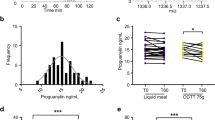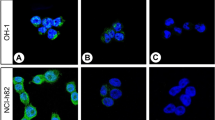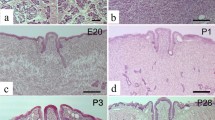Abstract
HUMAN urogastrone (hUG) is a polypeptide prepared from urine and is chemically similar to mouse epidermal growth factor (mEGF) prepared from submandibular salivary glands. Both these substances stimulate fibroblast proliferation in tissue culture systems. hUG and mEGF inhibit gastric acid secretion in experimental animals and hUG produces an identical effect in man. We show here, using immunofluorescent techniques, that hUG is present in the duct cells of human submandibular gland and in Brunner's gland cells in the first part of the duodenum. This work suggests that these polypeptides may have a role in mucosal growth and control of gastrointestinal secretion.
This is a preview of subscription content, access via your institution
Access options
Subscribe to this journal
Receive 51 print issues and online access
$199.00 per year
only $3.90 per issue
Buy this article
- Purchase on Springer Link
- Instant access to full article PDF
Prices may be subject to local taxes which are calculated during checkout
Similar content being viewed by others
References
Gray, J. S., Wieczorowski, X. X. & Ivy, A. C. Science 89, 489–490 (1939).
Gregory, H. Nature 257, 325–327 (1975).
Savage, C. R. J., Inogami, T. & Cohen, S. J. biol. Chem. 247, 7612–7621 (1972).
Gregory, H., Bower, J. M. & Willshire, I. R. Proc. 11th FEBS Meet. Copenhagen (Pergamon, Oxford, in the press).
Hollenberg, M. D. & Gregory, H. Life Sci. 267–274 (1976).
Cohen, S. & Carpenter, G. Proc. natn. Acad. Sci. U.S.A. 72, 1317–1321 (1975).
Elder, J. B., Ganguli, P. C., Gillespie, I. E., Gerring, E. L. & Gregory, H. Gut 16, 887–893 (1975).
Koffman, C. G. et al. Gastroenterology 72, 1082 (1977).
Elder, J. B., Ganguli, P. C., Gillespie, I. E., Delamore, W. I. & Gregory, H. Lancet ii, 424–427 (1975).
Fitzgerald, J. D., Barret, A. M. & Gregory, H. in The Physiology of Gastric Secretion (eds Semb, L. S. & Myren, J.) 408–411 (Univeritets Forlaget, Oslo, 1968).
Turkington, R. W., Males, J. L. & Cohen, S. Cancer Res. 31, 252; 256 (1971).
Gregory, H., Holmes, J. E. & Willshire, I. R. J. clin. End. Met. (in the press).
Van Noorden, S., Heitz, P., Kasper, M. & Pearse, A. G. E. Histochemistry 52, 329–340 (1977).
Kosaka, T. & Lim, R. K. S. Chinese J. Physiol. 4, 213–220 (1930).
Gregory, R. A. Secretory Mechanisms of the Gastro-Intestinal Tract (Arnold, London, 1962).
Creamer, B., Shorter, R. G. & Bamforth, J. Gut 2, 110–118 (1961).
Author information
Authors and Affiliations
Rights and permissions
About this article
Cite this article
ELDER, J., WILLIAMS, G., LACEY, E. et al. Cellular localisation of human urogastrone/epidermal growth factor. Nature 271, 466–467 (1978). https://doi.org/10.1038/271466a0
Received:
Accepted:
Issue Date:
DOI: https://doi.org/10.1038/271466a0
This article is cited by
-
Immunohistochemical localization of transforming growth factor ? in the major salivary glands of male and female rats
The Histochemical Journal (1993)
-
Distribution of epidermal growth factor in rat ocular and periocular tissues
Graefe's Archive for Clinical and Experimental Ophthalmology (1993)
-
Correlation between epidermal growth factor receptor concentration and the growth of human gastric cancer xenografts in nude mice
Gastroenterologia Japonica (1992)
-
Release and binding of epidermal growth factor in the pancreas of rats
International journal of pancreatology (1992)
-
The level of urinary epidermal growth factor is not influenced by the extent of psoriatic lesions
Archives of Dermatological Research (1991)
Comments
By submitting a comment you agree to abide by our Terms and Community Guidelines. If you find something abusive or that does not comply with our terms or guidelines please flag it as inappropriate.



